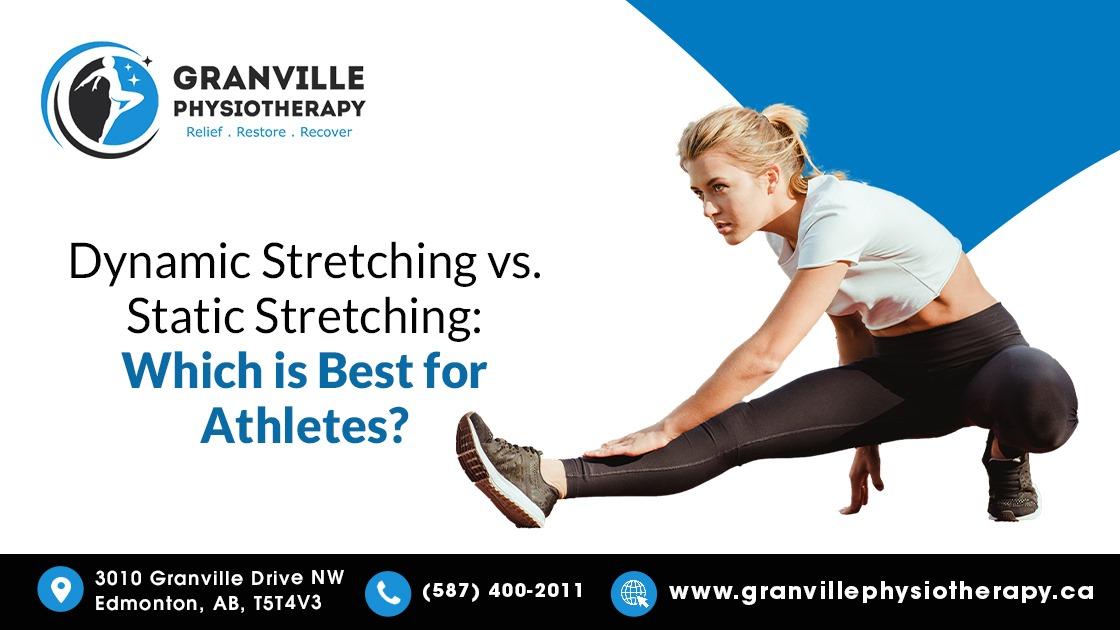
Stretching is an essential component of athletic training, but with so many methods, it can be confusing to know what works better. Two of the most common techniques are dynamic stretching and static stretching, each with its own unique benefits. But which one is better suited for athletes aiming to enhance performance and minimize the risk of injury?
Understanding the difference between these two stretching techniques and how they apply to sports is key. Sports physiotherapy Edmonton provides athletes with expert guidance on stretching and injury prevention for optimal results.
The Basics: What Is Dynamic Stretching
Dynamic stretching consists of moving parts of the body through a controlled, full range of motion in a controlled, continuous manner. Instead of holding a position, dynamic stretches mimic movements an athlete will perform during their sport. Examples include:
Leg swings: Forward and backward leg swings to engage the hip flexors, glutes, and hamstrings.
Arm circles: Large, controlled circles to warm up the shoulder joints.
Walking lunges: A compound stretch for the legs, hips, and core.
Dynamic stretching serves as a warm-up technique that enhances heart rate, blood flow, and muscle temperature, priming the body for physical activity. It helps activate muscles, enhances coordination, and prepares the nervous system for quick, powerful movements. This type of stretching is particularly beneficial before sports or high-intensity workouts.
The Basics: What Is Static Stretching?
Static stretching, on the other hand, involves extending a muscle to its limit and holding the position for a specific period, usually 15 to 60 seconds. Unlike dynamic stretching, static stretching does not involve movement. Some common static stretches include:
Hamstring stretch: Sitting and extending forward to touch the toes to stretch the back of the thighs.
Quadriceps stretch: Standing on one leg and pulling the opposite foot towards the glutes.
Triceps stretch: Extending one arm overhead and using the opposite hand to push it down gently.
Static stretching helps increase flexibility and range of motion over time. It relaxes muscles and is often used as a cool-down technique after intense physical activity, promoting recovery and reducing post-workout muscle soreness. However, holding static stretches before high-impact or explosive activities may reduce muscle strength temporarily, affecting performance.
Dynamic vs. Static Stretching: Which One Is Better for Athletes?
When comparing dynamic and static stretching, the choice often depends on timing, goals, and the type of sport or activity involved. Here’s a breakdown of when and why each stretching technique may be more beneficial for athletes:
1. Before Activity: Dynamic Stretching for Warm-Up
Dynamic stretching is widely regarded as the better option for warming up before sports. Research shows that it activates muscles, increases range of motion, and enhances blood flow to prepare the body for activity. For athletes, dynamic stretching before practice or a game reduces the risk of injury by loosening up tight muscles and promoting optimal muscle performance. Dynamic stretches can mimic the movements in a specific sport, whether it’s kicking in soccer, sprinting in track, or swinging in tennis.
By incorporating dynamic stretching, athletes also improve their coordination and agility, which are essential for quick, reactive movements. For instance, basketball players might perform a series of high-knee drills, lunges, and arm swings to prepare for the fast-paced and multidirectional movements in the game. In sports injury physiotherapy, dynamic stretching routines are often tailored to the athlete’s needs, ensuring that key muscle groups are activated for safe and efficient performance.
2. After Activity: Static Stretching for Cool-Down and Flexibility
Once a workout or game is over, static stretching becomes the preferred method. Holding stretches after physical exertion helps relax the muscles, promotes flexibility, and assists with recovery. Static stretching lengthens the muscle fibres, reducing tension and helping to prevent tightness that can lead to injuries over time.
For example, after a long run or an intense training session, stretching the calves, hamstrings, and quads can help athletes avoid stiffness and muscle imbalances. Sports physiotherapists often recommend static stretching as part of a cool-down routine, as it aids in reducing lactic acid buildup and promotes relaxation. Athletes who incorporate static stretching post-exercise may experience less soreness and a faster recovery, allowing them to train consistently without setbacks.
The Role of Sports Physiotherapy for Injury Prevention
Sports physiotherapy in Edmonton helps athletes prevent injuries through personalized stretching routines, targeted injury-prevention strategies, and tailored rehabilitation programs. Sports physiotherapists assess an athlete’s range of motion, flexibility, and muscle imbalances to design warm-up routines that reduce injury risk and enhance performance. In cases of injury, sports injury physiotherapy reintroduces safe stretching and strengthening exercises to aid recovery and prevent re-injury. Additionally, physiotherapists educate athletes on proper stretching techniques to ensure effective and safe muscle targeting.
Choosing the Right Stretching Routine for Optimal Athletic Performance
In the debate between dynamic and static stretching, both methods have their place in an athlete’s routine. Dynamic stretching energizes and prepares the body for activity, making it the preferred choice for warm-ups, while static stretching promotes recovery and flexibility, making it more suitable for post-workout cool-downs. For athletes looking to maximize their performance and prevent injuries, integrating both forms of stretching can yield better results.
Sports physiotherapy in Edmonton provides athletes with personalized routines that align with their sport, performance goals, and physical needs. Granville Physiotherapy in Edmonton offers expert services in athletic physiotherapy, helping athletes of all levels optimize their stretching routines, reduce injury risk, and enhance overall performance.
Also read about:
Welcoming Space Ideas by HOC Furniture Create a Warm and Stylish Home
Who Should Handle Financial Planning in a Growing Startup
BPC 157 5mg Why Choose Peptide ltd a Trusted GMP Peptide Manufacturer









